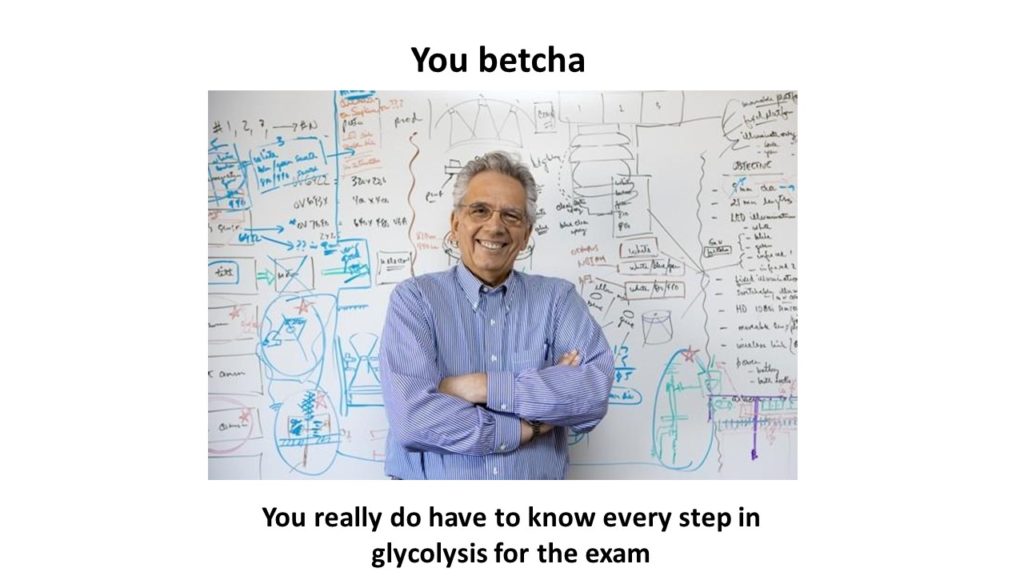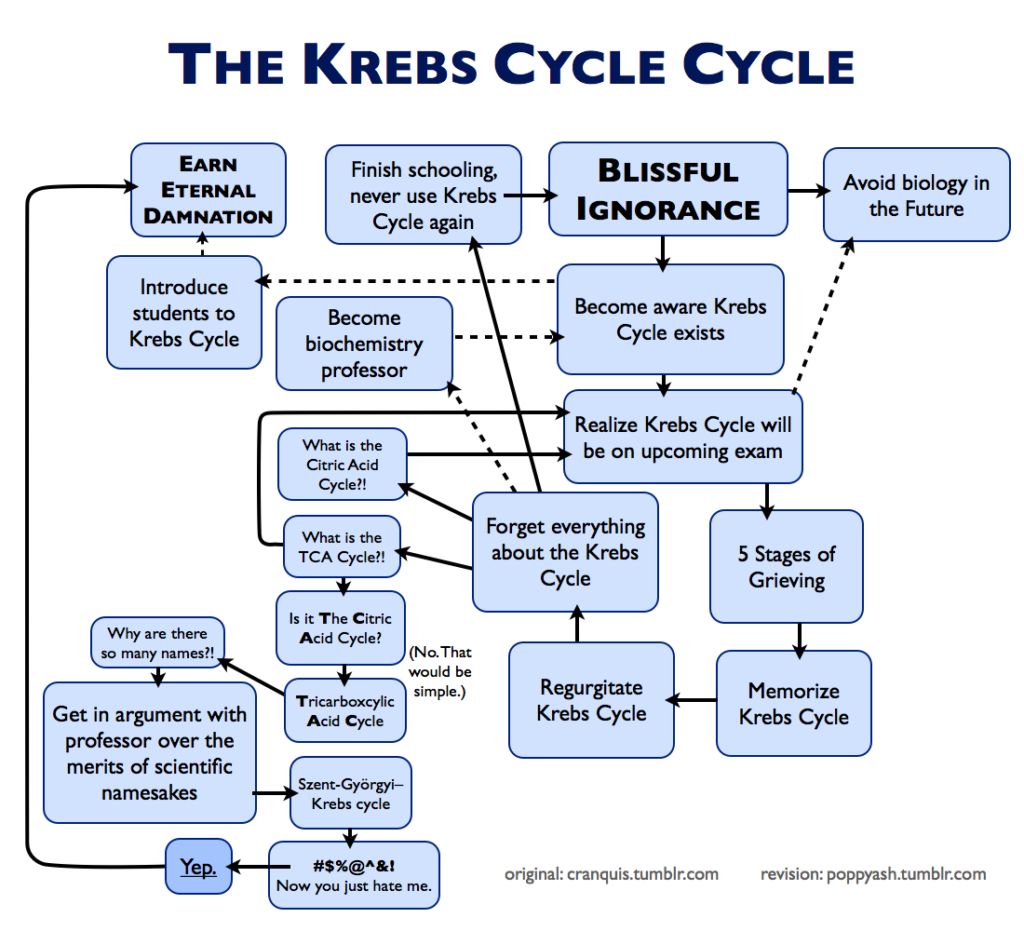Glycolysis and the Dreaded Krebs Cycle
Sounds like a great name for a band.
So now let’s talk about biochemical pathways. It is traditional to begin with glycolysis – the breakdown of glucose to form ATP.

The study of glycolysis is traditionally followed by the TCA cycle – or – the Tricarbocyclic Acid Cycle, Citric Acid Cycle. Take your pick – they are all the same thing.

OK. So it’s is not really a band but…..

There are two mechanisms of ATP generation. The first is substrate-level phosphorylation, where a high-energy phosphate group is transferred from the intermediate directly to ADP. The second is oxidative phosphorylation, where electrons are removed and passed through electron transport chains to oxygen.
TCA is the aerobic oxidation of glucose, with the goals of using acetyl CoA, produce reduced enzymes for the ETC and make a small amount of ATP via substrate level phosphorylation. Through a series of steps which are arranged in a circular pathway, the number of carbons fluctuates, beginning with the 2C acetal CoA reacting with oxloacetate (2C) to produce a 6C citrate.
Glycolysis is the first step in making ATP through cellular respiration, it occurs in the cytosol and is anaerobic. Glucose enters the glycolytic pathway from glycogenolysis, dietary fructose, dietary galactose.
It splits a 6C glucose into 2 3C molecules of pyruvic acid.
The goals of the Krebs (Tricarboxylic Acid) Cycle is to oxidize acetyl CoA from glucose and fatty acids. It also makes reduced coenzymes for the electron transport chain and releases carbon dioxide through oxidative decarboxylation. The reactions occur in the mitochondria, and acetate is oxidized in the form of acetyl CoA. When acetyl CoA enters the cycle, it combines with oxaloacetate to form citrate. Citrate is then decarboxylated to form alpha-ketoglutarate, which is decarboxylated to form succinate and succinate is converted to oxaloacetate.
CHO assimilation allows for liver and muscle to store a small amount of glucose as glycogen. The glucose from your food goes into storage or helps in ATP synthesis. The liver helps to maintain normal blood glucose levels. The excess glucose leaves the liver and goes to all tissues. It is important for glucose to reach the brain, and also the muscles and adipose tissue.
Catabolic pathways vs Anabolic pathways
Catabolic release energy by breaking down complex compounds into simpler compounds. This energy is stored in organic molecules to do work in the cell.
Anabolic pathways consume energy to build complicated molecules from simpler compounds. The energy released by catabolic pathways is used to drive anabolic pathways.
Enzymes selectively accelerate each step in metabolism. Enzymatic activity is regulated to maintain an appropriate balance of supply and demand.
During Carbohydrate Digestion in the intestinal lumen, galactose and glucose, along with Na+, enter through SGLT1 in order to be taken in later on by GLUT2. To prevent too much sodium in the cell, Na+ is regulated by a K+/Na+ pump. Fructose enters in a separate channel, GLUT5, to later enter GLUT2 alongside galactose and glucose.
Pentose Phosphate Pathway
– Alternative to glycolysis.
– Produce reduced Coenzyme via 2 dehydrogenation steps.
– Produce ribose-5-phosphate (5C sugar).
– Used to make NAD, FAD, DNA, RNA
– Releases CO2
– NADH + H+ = reduced coenzyme
– NADP+ = oxidized coenzyme
– Need for NADPH
When we have low oxygen (out of breath), the TCA cycle shuts down and the Cori cycle generates. Lactate will increase and the pH inside of the muscle cell will decrease, making it acidic. The lactate will then be shuttled to the liver through the blood to make glucose, costing us 6 ATP. However, this cycle is not efficient, instead, we want to stop and catch our breath (O2).
The electron transport chain (ETC) produces tons of ATP using the reduced forms of co-enzymes (NADH and FADH2) produced during glycolysis, the linking step, and the citric acid cycle.
NADH and FADH2 act as energy carriers. They carry the H+ and e- to the ETC at different sites (NADH to complex I, FADH2 to complex II). The protons are moved into the inter-membrane space, and oxygen is the final electron receptor.
The movement of e- through the complexes (with increasing electronegativity) and the translocation of H+ to the other side causes energy to be released. The concentration gradient (chemiosmosis) attracts the protons to ATPase, which creates the ATP and water as a byproduct.
After the formation of 1+ rings in a hydrocarbon, D-glucose exists in 2 isomers: α-D-glucopyranose and β-D-glucopyranose, which depends on orientation of hydroxyl group at C1. The alpha formation has the hydroxyl group pointed below the molecule. The beta formation has the hydroxyl group pointed out an up from the molecule.
There are two forms of regulation in regards to digestion. Neural regulation is a faster process where nerves line walls of the GI tract and respond to stimuli like food, pressure, and acid. Hormonal regulation is more sustained. It is done via regulatory peptides and releases peptides in response to chyme, which move into the blood, then the target organ, leading to action.
Two Shuttle Systems: Reducing equivalents generated in glycolysis need to be transported across the mitochondrial membrane from the cytoplasm
1. Malate-Aspartate Shuttle System is the more active shuttle in the kidney, liver, and heart. NAD+ receives the reducing equivalent (H+ or e-) from malate crossing the mitochondria membrane. 38 ATP is generated per glucose when this shuttle occurs.
2. Glycerol Phosphate Shuttle is less active and occurs in the brain and skeletal muscle. FAD receives reducing equivalent from Coenzyme Q which receives the electron from G3P. 36 ATP is generated per glucose when this shuttle occurs.
A reducing sugar is a monosaccharide that oxidizes to give a carboxylic acid while reducing another compound. Monosaccharides which are reducing sugars include glucose, fructose, and galactose. D-Galactose, for example, is a monosaccharide which is also a reducing sugar since it forms a cyclic hemiacetal which opens up and frees an aldehyde group which can reduce other compounds.
Gluconeogenesis is the reversal of glycolysis. Steps 10, 3, and 1 of glycolysis are irreversible so during gluconeogenesis these steps need to be bypassed. Pyruvate carboxylate is used to turn pyruvate into OAA and then PEPCK to form PEP in step 10. F-1,6-Bisphosphate goes to Fructose-6-P by Fructose-1, 6-BisPhosphatase in step 3. G6P in step 1 goes to glucose by Glucose-6-Phosphatase. Gluconeogenesis goes uphill thermodynamically by converting 2 pyruvate into 1 glucose. Precursors include amino acids, glycerol, and lactate.
Polysaccharides are many monosaccharides put together (examples include fiber, starch, glycogen)
Disaccharides are two monosaccharides put together (there is maltose (glucose+glucose)-can be a reducing sugar, lactose (glucose+galactose)-can be a reducing sugar, sucrose (glucose+fructose)-can’t be reducing sugar
Monosaccharide is one saccharide (sugar) (glucose, galactose, fructose)
The pyruvate dehydrogenase complex links glycolysis with the TCA cycle. It involves oxidative decarboxylation (removing CO2), dehydrogenation (removes H+ and e- to form NADH + H+), and an acetyl group attaching to coenzyme A to form acetyl-coenzyme A (this enters the TCA cycle).
The linking step of pyruvate to the TCA cycle is Aerobic Oxidation of Glucose. During this process, pyruvate is turned into Acetyl CoA using pyruvate dehydrogenase complex.
2 important things to remember about the Pyruvate Dehydrogenase Complex are:
1. it is the bridge between glycolysis and the TCA
2. NADH is created and sent to the electron transport chain, where ATP can be created
During glycogenolysis in the muscle and liver Glucose-1-P is isomerized by the enzyme phosphoglucomutase (moves a phosphate to a different spot on the glucose molecule) and becomes Glucose-6-Phosphate. In the muscle, G-6-P enters glycolysis. In the liver, Glucose-6-Phospahate is dephosphorylated by Glucose-6-Phosphatase to become Glucose and then is released into the bloodstream.
CoASH:
CoASH is part of the process in making Acetyl-CoA. This is seen in the pyruvate dehydrogenase complex. This is seen towards the end of the complex, where CoASH reacts with acyl-lipoate to create the Acetyl CoA product. CoASH has a thio-ester linkage that is similar to other ester linkages but with a S, which contains a high energy bond and it therefore less stable. It wants to be able to hydrolyze and drive the reaction forward.
– Digestion refers to simply breaking large molecule in foods into smaller molecules by adding water. It is not “into” our body yet.
– Absorption refers to the transport or transfer of the products of digestion into the blood stream, then the blood would be carrying those molecule into cells. Bringing the food molecule “into” our body.
Glycemic index: the increase in blood glucose over the baseline during a 2hr period following ingesting of a defined amount of carbohydrates compared with the same amount of carbohydrate in a reference food.
Glycemic load:accounts for how much carbohydrates is in the food and how much each gram of carbohydrates raises blood glucose
Cholecystokinin: A hormone released by the duodenum. It it is released in response to partially hydrolyzed fat (fatty acids), proteins (amino acids and peptides), as well as an acidic pH of chyme. Cholecystokinin stimulates the gall bladder to contract and release bile to assist in digesting fats. Cholecystokinin also stimulates the release of a particular secretion from the pancreas. It contains digestive enzymes and proenzymes. These enzymes work most efficiently when there is a neutral pH, so that the HCO3 helps establish the proper pH.
Succinyl CoA:
Succinyl CoA can be formed from methylmalonyl CoA through the utilization of deoxyadenosyl-B12 by the enzyme methylmalonyl-CoA mutase. This reaction needing vitamin B12 as a cofactor is important in the catabolism of some branched-chain amino acids and odd-chain fatty acids.